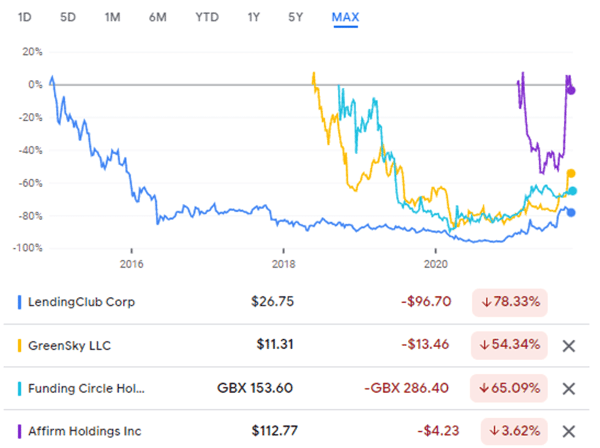While we have seen a recent uptick in fintech stock performances for some, underperformance has been a common thread amongst online lenders in the past. Which fintech group merits your attention most?
Why online lenders underperform debuts
As you are well aware by now, we have seen a flurry of SPAC deals hitting the markets with the most recent example being SoFi under Chamath Palihapitiya, Affirm in January, and Upstart whose performance has been up 1,100% in one year. One issue that continues to persist with online lending companies going public is their evident over valuation in the private markets which ends up hunting them down later.
Online lenders churn out income by charging what’s called an origination fee, a small percentage of a loan’s principal, which usually ends up being somewhere between $500 and $2,000 dollars. But subtract CAC from these numbers and, the business model becomes much less exciting in the eyes of investors. This information is translated upon public market entry in a devaluation because when online lenders hit large exchanges, they face far more scrutiny than before, and see their financials revert to market in what is usually, a downward trend.
We take the examples on Lending Club, GreenSky, Funding Circle and Affirm, with SoFi aside because they’ve made 54% since debuting. Yes, online lenders on a one-year basis are all in the green with a median performance of 123.85% (SoFi excluded), but that is all short-term talk. the next graphic clearly shows a downward facing long term trend. Are all facing the same fate though? Probably not, but the message is clearly one of a disconnect between private and public worlds.

What changes between private markets and public ones you ask? The underwriting criteria. Venture capital or the ‘’private world’’, measures future income as though online lenders are running software as a service business models with growth potential in cloud and open banking solutions (true in theory, harder to do). However, In the ‘’public world’’, professional investors look at online lenders like… lenders. They have balance sheets with liabilities, and they have credit risk so they look somewhat like banks in terms of valuation dynamics. Add to this the fact that capital for online lenders is not cheap and that they ultimately rely on incumbents for financing, which diminishes their pricing power and competitive strategy. But this is also about to change as we explored in our last article featuring Lending Club’s neo banking evolution with their Radius acquisition. Online lenders and banks are aiming for a similar direction now.
Affirm is an interesting example to look at now because it is classified as a buy now pay later company. It is well known to be Peloton’s crutch, and at the end of day all their business revolves around giving people easy and reachable credit solutions. It’s just packaged differently, but really, it’s an online lending business model: despite a positive correction seen recently, Affirm imploded for some time after debuting because of this business model.
So again, valuation in the private world looks at online lending revenue models like recurring SaaS revenue when in fact, it might be closer in nature to liabilities, at least to investors. Online lenders don’t sell software with minimal marginal costs and near infinite scalability, and public markets know this hence the prices correctly correcting.
What about neobanks and brokerages?
It's complicated, but there is something of note for digital banking apps when looking at Chime’s direct deposit business model. You should look at direct deposits as a growth lever for digital banking because it allows users an early paycheck option which in turn is used to plug data in a machine learning engine that can predict credit needs. Chime does this, and now has 15 million users. They’re one of the most anticipated private companies because of this, as they are building a data mine worthy of attention.
Brokerages, so things like digital investing platforms Robinhood, and eToro have not exactly lived up to their value creation even though Robinhood is 22% up from its debut. Coinbase, who deals in crypto, is down 34% since inception however. Coinbase commands a $5B ARR which implies a 10X revenue multiple considering a market cap of $50 billion. One thesis is that once investors get well acquainted with the volatile nature of cryptocurrencies, such lofty valuations could eventually swing downwards.
And payment companies?
Payment companies have a different source of income since their revenues are secular and sticky due to mobile integration! This makes payment firms growth friendly ventures with recurring revenues much closer to software business models.
They charge small fees in a massive ecosystem and touch upon more industries (low marginal cost, high scale). This software as a service model is perhaps why payments valuations between the private world and the public world don’t change in the same way online lenders’ do.
As an example of how differently public markets treat payments we look to Wise. Wise, a cross border remittance firm, has done well in its recent direct listing. Its 25% YTD jump is underlined by a $650 million ARR figure yielding a market cap of £11B, or a market cap ratio of 17X. On the other hand, Payoneer is down 15% since hitting market so not all new payments are as successful.
Before we part, know that PayPal last week, introduced customers to a new world of payment apps with new features and services in things like high yield savings, in-app shopping tools, rewards, and quick direct deposits.
We highlighted above the value of direct deposits in machine learning models for predictability optimization. Because PayPal’s mega-app does everything, it in a sense, becomes a bit less specialized, so therefore less differentiated as it takes on more competitors. Let's see where this leads then.





